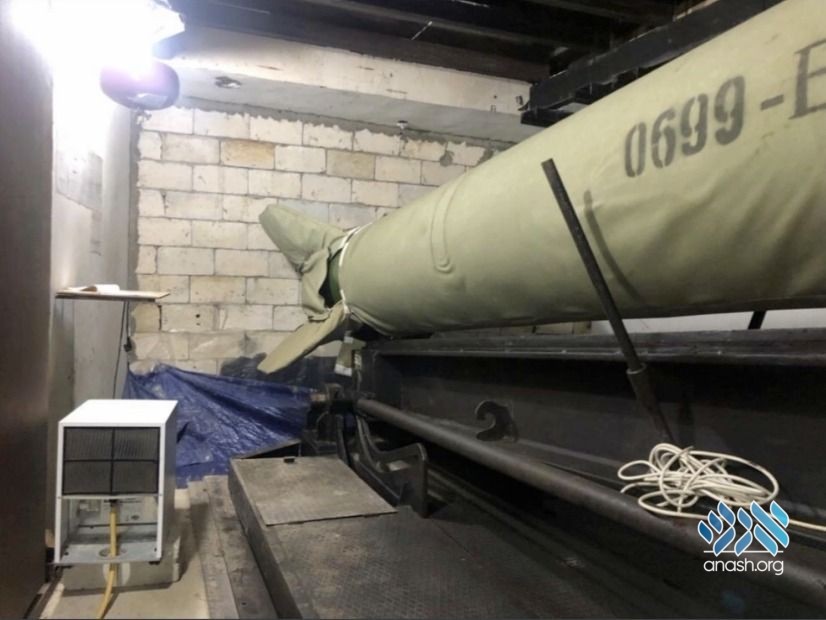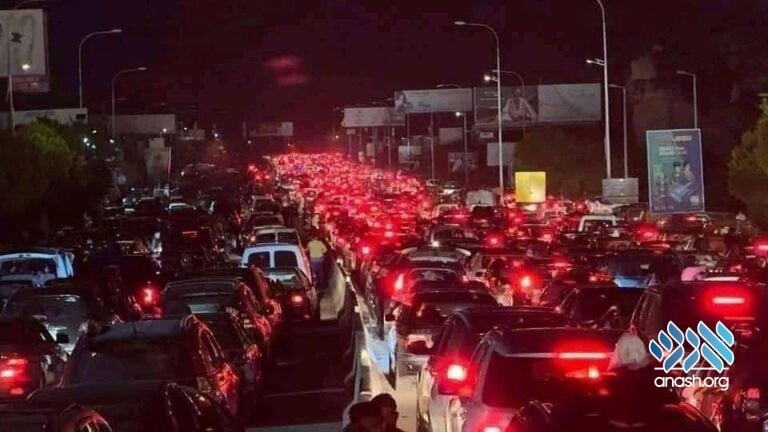כ״א אלול ה׳תשפ״ד | September 24, 2024
War Day 354: Hezbollah at Crossroads of Larger War, Mass Evacuations from Lebanon
War Summary, Day 353-354: Gaza war preparing for new stage, Hezbollah escalates weight and distance of rocket fire, homes hit in Israel with no serious casualties, school out for half a million children, IDF continues to take out Hezbollah’s senior command, Hezbollah at crossroads of declaring larger war, mass evacuations in Lebanon with many heading to Syria, and Iran may still join in directly.

War Summary, Day 353-354: Gaza war preparing for new stage, Hezbollah escalates weight and distance of rocket fire, homes hit in Israel with no serious casualties, school out for half a million children, IDF continues to take out Hezbollah’s senior command, Hezbollah at crossroads of declaring larger war, mass evacuations in Lebanon with many heading to Syria, and Iran may still join in directly.
By Mrs. Bruria Efune
101 held captive in Gaza.
35 hostages confirmed murdered held in Gaza.
117 living hostages rescued.
37 hostage bodies rescued.
1,652 Israelis killed.
350 fallen soldiers and police in the battle in Gaza.
25 fallen soldiers in Northern Israel.
14 fallen soldiers and police in Judea & Samaria.
25,000 estimated projectiles fired at Israel.
88,000 Israelis displaced from their homes.
1 Jewish nation united in prayer, charity, and good deeds.
Top Headlines:
- No news on Sinwar
- Gaza war preparing for new stage
- Hezbollah escalates weight and distance of rocket fire
- Homes hit in Israel, no serious casualties
- School out for half a million children
- Record-breaking IAF strikes in Lebanon
- IDF continues to take out Hezbollah senior command
- Hezbollah at crossroads of declaring larger war
- Mass evacuations in Lebanon, many heading to Syria
- Iran may still join in directly
Hostage Updates:
There is no progress in hostage negotiations. The IDF is now developing a new strategy for their release.
Gaza Front Updates:
Hamas did not fire any rockets into Israel today.
Thank G-d, the IDF did not announce any fallen heroes.
Three divisions of IDF troops are currently operating in Gaza: the 252nd Division along the Netzarim Corridor, and pinpoint operations in Central Gaza and Gaza City; the 162nd Division in Rafah and along the Philadelphi Corridor; and the Gaza Division in the buffer zone.
The IDF has not been detailing airstrikes in Gaza as of late, though it appears that most are now being done with combat helicopters, while jets are preoccupied with Lebanon. On Monday, the IDF targeted a Hamas command room embedded in a school in Central Gaza, amongst other airstrikes. Several airstrikes were reported in Gaza City on Tuesday.
The IDF is now preparing for the next stage in Gaza, of which a key element will be removing Hamas control over civilians, particularly through control of humanitarian aid. The security establishment hasn’t to yet decided on the method, whether it will be through the General’s Plan of clearing out Northern Gaza, or through an alternative plan.
The status of Hamas leader, Yahya Sinwar, still remains unknown. There is no evidence of his elimination, however, there are suspicions that communications in his name two weeks ago, were in fact written by someone else. There has been no communication from him since. Sinwar has gone silent in the past, and relies heavily on trusted messengers to communicate with the outside world.
Gaza Humanitarian Efforts Updates:
On Monday:
155 trucks carrying humanitarian goods were transferred to Gaza, 116 through the Kerem Shalom Crossing to the south and center of Gaza, and 39 via the Erez Crossing to the north of Gaza.
Approximately 490 trucks worth of aid are waiting in total for collection, 480 of which are the UN’s responsibility.
6 gas tankers designated for the operation of essential infrastructure in Gaza, entered Gaza.
Hamas continues to hijack most of the aid, and either keep it for themselves, or sell it at a high profit.
Northern Front Updates:
Hezbollah has been firing up of 200 projectiles at Israel daily, reaching as far as the Shomron in one instance, with most heavy focus on the border communities, Tzfat area, and Nazareth area (where they claim to be targeting sensitive IDF bases, but keep missing).
As of September 22nd, Hezbollah began using Fadi-2 rockets, which have a 100km range, and 170kg warhead.
While a few homes were hit, and several wildfires started, Israeli casualties remain low, thank G-d. Over the last two days, two adults were moderately injured and several others were lightly injured. Residents of Palestinian Authority villages also got to experience Hezbollah fire, with one home hit and two moderately injured. The IDF provides Iron Dome protection for the Palestinian Authority as well.
School remains closed for over half a million children in Israel. While the government authorized a rare special security situation for all of Israel, Home Front Command restrictions remain in place only in Northern Israel, from Haifa up. In other parts of Israel, residents are asked to remain vigilant.
IDF Chief of Staff Lt. Gen. Herzi Halevi has chosen a name for the military’s offensive operation against Hezbollah in Lebanon: “Northern Arrows.”
The war is not yet at peak escalation. The IDF’s airstrikes are vast, but still very limited to Southern Lebanon and the Beqaa Valley, with very minimal strikes in Beirut. In turn, Hezbollah is still avoiding targeting Tel Aviv or densely populated cities in Israel, and hasn’t used any guided missiles yet. Lebanon has not yet decided if they want to risk a complete war, in which they’ll likely be annihilated, or plea for a way out—and Israel seems to have still left that door open for them. Expect the IDF to step-by-step accelerate operations, until it’s too late for Hezbollah to back out.
A very recent publication of Hezbollah indicates that they are leaning towards war, too proud to surrender.
Over the last 24 hours, the Israeli Air Force carried out the most extensive airstrikes in Israel’s history, hitting over 1,600 Hezbollah terror targets in Lebanon. Over 250 fighter jets assisted in the strikes, and dropped around 2,000 munitions. The Air Force is targeting Hezbollah’s two main capabilities: the elite Radwan Forces, and Hezbollah’s arsenal of rockets, missiles, and drones.
The Radwan forces are highly trained terrorist militants, who were preparing to invade Northern Israel. On Friday, the IAF already took out almost the entire Radwan top leadership.
Hezbollah is estimated to have anywhere between 120,000 – 200,0000 rockets and missiles. On Monday, IDF Spokesman Rear Adm. Daniel Hagari, said that the IDF took out “dozens of thousands” of Hezbollah’s arsenal. This could mean up to a third, possibly more, of Hezbollah’s fire power.
Before carrying out airstrikes on targets where civilians may be present, the IDF called on people in Lebanon to evacuate any site containing Hezbollah assets, with a distance of at least 1 kilometer, and to evacuate the entire Beqaa Valley. Most civilians heeded warnings immediately, and in a few towns in Southern Lebanon, there are even reports that Hezbollah went door-to-door telling people to evacuate. The IDF published materials showing how Hezbollah stores massive missiles and other arsenal inside civilian homes, often for pay, with launching systems embedded in the roofs of the homes.
The Lebanon Health Ministry reports 600 dead and nearly 2,000 injured, the IDF estimates that most of the dead are Hezbollah terrorists.
The IDF has also been targeting all of Hezbollah’s top leadership, regardless of their location. If in a heavily populated area, the IAF used precision missiles to minimize harm.
Yesterday, an airstrike reportedly targeted Ali Karki, the commander of Hezbollah’s southern command, who had just been appointed to replace Ibrahim Aqil. Initial reports indicated that he had been eliminated, but later, Hezbollah claimed that he was safe and well.
Today (Tuesday), an airstrike targeted and successfully eliminated Ibrahim Qbaisi, the head of Hezbollah’s rocket and missile division, while meeting in an apartment in Beirut. Qbaisi had previously been a subordinate to former military leader, Fuad Shakar, and after his elimination, may have answered directly to Hezbollah Secretary General, Hassan Nasrallah. His elimination is a huge blow to Hezbollah’s rocket capabilities. Several other senior commanders of the missile and rocket division were eliminated in the apartment alongside Qbaisi.
Many of Hezbollah’s top spiritual leadership, who preach jihad against the Jews, were also eliminated.
There are now over 20,000 displaced Lebanese in displacement centers, and thousands more headed to Syria. In some Druze and Christian towns, locals put up roadblocks and are not allowing entrance to anyone who may be remotely connected to Hezbollah.
Iran Updates:
Reports indicate that Iran is not happy with the IDF’s successful attacks on Hezbollah, and is hoping for de-escalation.
Iran is afraid of losing Hezbollah, which they needed for protection in case of an IDF attack on Iranian nuclear assets. Hezbollah was supposed to be able to deter Israel from attacking Iran, or prevent Israel from defending against an Iranian nuclear attack, by firing heavy barrages of missiles on Israel, and overwhelming Israel’s air defense systems. But Hezbollah is quickly losing that ability.
Iran now has to decide if they will step in to try and help Hezbollah, or sit aside and watch them be annihilated. Iran knows that they will likely be hit hard by the IDF if they do get involved. However, they may attempt to force Israel into a diplomatic agreement to halt fire, by critically raising the risk to civilians in Israel, or by threatening Western countries into pressuring Israel to stop.
However, Iran historically does not like to be in the center of a war—which is why they create so many proxies which they can sacrifice instead. The question is if they are ready to lose their largest proxy, in which they invested billions of dollars, and decades of efforts.
The IDF has not ruled out the possibility of Iran joining in.




Any more info on the new strategy for their release?